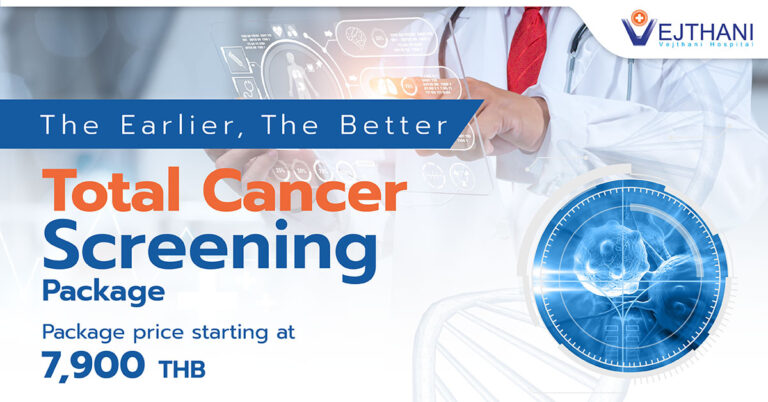Arthroscopic Knee and Joint Surgery in Bangkok, Thailand
Arthroscopy (also called arthroscopic surgery) is a minimally-invasive surgical procedure in which an examination and sometimes treatment of damage of the interior of a joint is performed using an arthroscope, a type of endoscope that is inserted into the joint through a small incision. Arthroscopic procedures can be performed to evaluate or treat many orthopedic conditions, including torn floating cartilage, torn surface cartilage, ACL reconstruction, and trimming damaged cartilage. Vejthani Hospital offers shoulder, wrist, spinal, ankle and knee arthroscopic surgery in Bangkok, Thailand.
The advantage of arthroscopy over traditional open surgery is that the joint does not have to be opened up fully. Instead, only two small incisions are made. In the case of a knee procedure, one incision is made for the arthroscope and one for the surgical instruments to be used in the knee cavity to fully remove the kneecap. This reduces recovery time and may increase the rate of surgical success due to less trauma to the connective tissue. It is especially useful for professional athletes, who frequently injure knee joints and require faster healing times. There is also less scarring because of the smaller incisions. Irrigation fluid is used to distend the joint and make a surgical space in traditional open surgery. Sometimes this fluid leaks into the surrounding soft tissue causing extravasation and edema.
The surgical instruments used in arthroscopy are smaller than traditional instruments. Surgeons view the joint area on a video monitor and can diagnose and repair torn joint tissue, such as ligaments and menisci or cartilage.
It is technically possible to do an arthroscopic examination of almost every joint in the human body. The joints that are most commonly examined and treated by arthroscopy are the knee, shoulder, elbow, wrist, ankle, foot, and hip.
Knee Arthroscopic Surgery in Thailand
Arthroscopic knee surgery in Thailand has, in many cases, replaced the classic arthrotomy (open surgery) that was performed in the past. Today knee arthroscopy is commonly performed for treating meniscus injury, reconstruction of the anterior cruciate ligament and for cartilage microfracturing. Arthroscopy can also be performed for diagnosing and checking the knee; however, the latter use has been mainly replaced by magnetic resonance imaging.
During an average knee arthroscopic surgery at a hospital in Bangkok, a small fiber-optic camera (the endoscope) is inserted into the joint through a small incision, about 4 mm (1/8 inch) long. A special fluid is used to visualize the joint parts. More incisions might be performed in order to check other parts of the knee. Then, other miniature instruments are used to perform the surgery.
Recovery after a knee arthroscopic surgery in Thailand is significantly faster compared to an arthrotomy (open surgery). Most patients can return home and walk using crutches the same or the next day after the surgery. Recovery time depends on the reason that surgery was needed and the patient’s physical condition. Usually, a patient can put weight on their leg within a couple of days and after a few weeks, the joint function can fully recover. It is not uncommon for athletes who have an above-average physical condition to return to normal athletic activities within a few weeks.
Arthroscopic surgeries of the knee in Thailand are done for many reasons, but the usefulness of surgery for treating osteoarthritis is doubtful. A double-blinded placebo-controlled study on arthroscopic surgery for osteoarthritis of the knee was published in the New England Journal of Medicine in 2002. In this three-group study, 180 military veterans with osteoarthritis of the knee were randomly assigned to receive arthroscopic debridement with lavage, just arthroscopic lavage, or a sham surgery, which made superficial incisions to the skin while pretending to do the surgery. For two years after the surgeries, patients reported their pain levels and were evaluated for joint motion. Neither the patients nor the independent evaluators knew which patients had received which surgery. The study reported, “At no point did either of the intervention groups report less pain or better function than the placebo group.”
Because there is no confirmed usefulness for these surgeries, many insurance agencies are reconsidering paying for a surgery that seems to create risks with no benefit. A 2008 study confirmed that there was no long-term benefit for chronic pain, above medication and physical therapy. One of the main reasons for arthrosopy is to repair or trim a painful and torn or damaged meniscus. However, a recent study in the New England Journal of Medicine showing that about 60% of these tears cause no pain and are found in asymptomatic subjects, may further call the rationale for this procedure into question.
Shoulder Arthroscopy
Arthroscopic surgery in Thailand is commonly used for treatment of various conditions of the shoulder, including subacromial impingement, acromioclavicular osteoarthritis, rotator cuff tears, frozen shoulder (adhesive capsulitis), chronic tendonitis and partial tears of the long biceps tendon, SLAP lesions and shoulder instability.
Wrist Arthroscopy
Arthroscopic surgery of the wrist in Thailand is used to investigate and treat symptoms of repetitive strain injury, fractures of the wrist and torn or damaged ligaments. It can also be used to ascertain joint damage caused by arthritis.
Spinal Arthroscopy
Many invasive spine procedures involve the removal of bone, muscle, and ligaments to access and treat problematic areas. In some cases, thoracic (mid-spine) conditions require a surgeon to access the problem area through the rib cage, dramatically lengthening recovery time.
Arthroscopic (also endoscopic) spinal surgery in Thailand allows the surgeon to access and treat a variety of spinal conditions with minimal damage to surrounding tissues. Recovery times are greatly reduced due to the relatively small size of incision(s) required, and many patients are treated on an outpatient basis. Recovery rates and times vary according to condition severity and the patient’s overall health.
Spinal Arthroscopic Procedures can treat
- Spinal disc herniation and degenerative discs
- Spinal deformity
- Tumors
- General spine trauma
- Readers Rating
- Rated 4.1 stars
4.1 / 5 ( Reviewers) - Excellent
- Your Rating
























